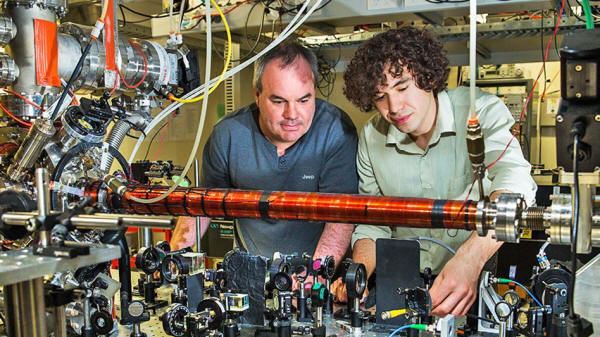|

27 May 2015
from
ANU Website

Associate Professor Andrew Truscott (L)
with PhD student Roman Khakimov.
The bizarre nature of reality as laid out by quantum theory has
survived another test, with scientists performing a famous
experiment and proving that reality does not exist until it is
measured.
Physicists at the Australian National University (ANU)
have conducted John Wheeler's delayed-choice thought
experiment, which involves a moving object that is given the choice
to act like a particle or a wave.
Wheeler's experiment then
asks - at which point does the object decide?
Common sense says the object is either wave-like or particle-like,
independent of how we measure it.
But
quantum physics predicts that
whether you observe wave like behavior (interference) or particle
behavior (no interference) depends only on how it is actually
measured at the end of its journey.
This is exactly what the
ANU team found.
"It proves that
measurement is everything. At the quantum level, reality does
not exist if you are not looking at it," said Associate
Professor Andrew Truscott from the ANU Research School of
Physics and Engineering.
Despite the apparent
weirdness, the results confirm the validity of quantum theory, which
governs the world of the very small, and has enabled the development
of many technologies such as LEDs, lasers and computer chips.
The ANU team not only succeeded in building the experiment, which
seemed nearly impossible when it was proposed in 1978, but reversed
Wheeler's original concept of light beams being bounced by mirrors,
and instead used atoms scattered by laser light.
"Quantum physics'
predictions about interference seem odd enough when applied to
light, which seems more like a wave, but to have done the
experiment with atoms, which are complicated things that have
mass and interact with electric fields and so on, adds to the
weirdness," said Roman Khakimov, PhD student at the Research
School of Physics and Engineering.
Professor Andrew
Truscott's team first trapped a collection of helium atoms in a
suspended state known as a
Bose-Einstein condensate, and then
ejected them until there was only a single atom left.
The single atom was then dropped through a pair of
counter-propagating laser beams, which formed a grating pattern that
acted as crossroads in the same way a solid grating would scatter
light.
A second light grating to recombine the paths was randomly added,
which led to constructive or destructive interference as if the atom
had travelled both paths. When the second light grating was not
added, no interference was observed as if the atom chose only one
path.
However, the random number determining whether the grating was added
was only generated after the atom had passed through the crossroads.
If one chooses to believe that the atom really did take a particular
path or paths then one has to accept that a future measurement is
affecting the atom's past, said Truscott.
"The atoms did not
travel from A to B. It was only when they were measured at the
end of the journey that their wave-like or particle-like
behavior was brought into existence," he said.
The research (Wheeler's
Delayed-choice Gedanken Experiment with a Single Atom) is
published in Nature Physics.
|


